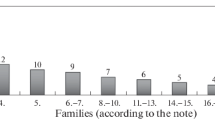Summary
-
1.
The bottle gourd,Lagenaria siceraria, and the five cultivated species ofCucurbita are the cucurbits commonly found in archeological sites.
-
2.
The archeological history of the bottle gourd indicates that it was one of the first plants to be domesticated in the Americas. In many sites, it is found in pre-ceramic, pie-maize strata. In the Old World,La-genaria was never so widely distributed nor used as in the Americas, probably because of the early invention of pottery in Asia.
-
3.
The center of distribution of the genusCucurbita is apparently in the region directly south of Mexico City. In this general area, there are several wild species that are compatible with the cultivated species.
-
4.
The cultivated species ofCucurbita, in general, are characterized by an allopatric distribution. The archeological record suggests that each species was domestitcated at different times and almost certainly in different areas.
-
5.
The cultural history of the cucurbits indicates a very strong tendency towards conservative crop husbandry among pre Columbian and post-Columbian peoples in that they tended to grow essentially the same cultivars over long periods of time.
Similar content being viewed by others
Literature Cited
Carter, G. F. 1945. Some archeologic cucurbit seed from Peru. Acta Americana3: 163–172.
Cogniaux, A., and H. Harms. 1924 Das Pflanzenreich: IV (A. Engler) Cucurbite —Cucumerinae275 (11): 200–209.
Cutler, H. C. and Thomas W. Whitaker. 1961. History and distribution of the cultivated cucurbits in the Americas. Amer. Antiquity26: 469–485.
-, and -. 1965. Cucurbits from the Tehuacán Caves. In press.
Meeuse, A. D. J. 1962. The Cucurbitaceae of South Africa. Bothalia7: 1–111.
Sauer, C. O. 1950. Cultivated plants of South and Central America. Bull. 143, Handbook of South American Indians6: 487–543. Smithsonian Inst, Bur. Amer. Ethnology.
St. Pierre, Germainde. 1866. Bull. Soc. Bot. Fr.13: 301–304.
Vestal, P. A. 1938.Cucurbita moschata found in pre-Columbian mounds in Guatemala. Harvard Univ. Bot. Leaflets6: 65–69.
Whitaker, Thomas W. and J. B. Bird. 1949. Identification and significance of the cucurbit materials from Huaca Prieta, Peru. Amer. Museum Nov. No. 1426, pp. 1–15.
—, H. C. Cutler and R. S. MacNeish. 1957. Cucurbit materials from three caves near Ocampo, Tamaulipas. Amer. Antiquity22: 352–358.
Author information
Authors and Affiliations
Rights and permissions
About this article
Cite this article
Whitaker, T.W., Cutler, H.C. Cucurbits and cultures in the Americas. Econ Bot 19, 344–349 (1965). https://doi.org/10.1007/BF02904804
Received:
Issue Date:
DOI: https://doi.org/10.1007/BF02904804




